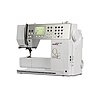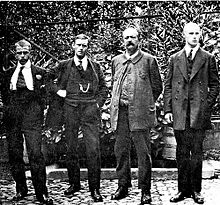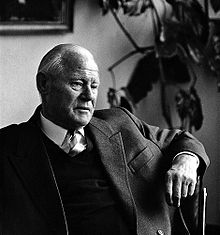Bernina sewing machine factory
| BERNINA International AG
|
|
|---|---|
| legal form | Corporation |
| founding | 1893 |
| Seat | Steckborn , Switzerland |
| management | Hanspeter Ueltschi (Owner and Chairman of the Board of Directors) Claude Dreyer ( CEO ) |
| Number of employees | 1038 (annual average 2016) |
| sales | CHF 186 million (consolidated sales 2016) |
| Branch | Textile machines |
| Website | www.bernina.com |
Bernina International AG (formerly Fritz Gegauf AG ) based in Steckborn in Switzerland is a sewing machine manufacturer founded in 1893 . The origin of the company lies in the invention of the hemstitch sewing machine in 1893 by Karl Friedrich Gegauf. The sewing and embroidery systems developed to this day enable sewing , embroidery , quilting and overlocking.
history
1890–1926: Karl Friedrich Gegauf and the invention of the hemstitch sewing machine
The beginnings of today's Bernina International go back to Karl Friedrich Gegauf (* 1860 in Wahlwies ; † 1926), who discovered his passion for technology as a child. After graduating, he worked in the Baum embroidery machine factory in Rorschach . In 1890, Karl Friedrich Gegauf set up an embroidery and mechanical workshop for the manufacture of the monogram embroidery machines he had invented in Steckborn, Switzerland. Together with his brother Georg Gegauf, Karl Friedrich Gegauf ran the “Gebrüder Gegauf” company. In 1893 Karl Friedrich Gegauf invented the first hemstitch sewing machine; with this, 100 stitches per minute could be sewn. In 1885 a major fire completely destroyed the Gegauf brothers' workshop, only the prototype of the hemstitch sewing machine could be saved. At the end of the 1920s, artificial silk appeared in the textile industry , which was not suitable for hemstitching. In the course of this, Karl Friedrich Gegauf considered how some work in the production of rayon could be done with machines, such as threading (tying off the strands of yarn). He drew up plans for a Fitzmaschine and set up a new workshop for its construction. But shortly before the first machine could be manufactured, Karl Friedrich Gegauf died. His sons Fritz and Gustav took over the company and produced, among other things, the Fitz machine.
1926–1947: Fritz Gegauf and the development of the first household sewing machine «Bernina»
Fritz Gegauf (1893–1980), one of Karl Friedrich Gegauf's sons, registered the patent for the “Wotan hemstitch sewing machine” as early as 1919, which was another international success for the company now known as “Fritz Gegauf”. In 1926, after the death of his father, he took over the management of the factory together with his brother Gustav. During the economic crisis of the 1930s, Fritz Gegauf teamed up with the Brütsch & Sohn embroidery factory in St. Gallen , which was also in the red. By the end of 1932 they developed the first household sewing machine, which they called the "Bernina". On October 26, 1937, the twenty thousandth machine left the Steckborn factory. In 1938 he launched the first Bernina zigzag sewing machine and in 1945 the world's first portable zigzag sewing machine. One million Bernina zigzag sewing machines had been produced in Steckborn by mid-1963 - since then the company has been known as “Bernina”.
1959–1988: Odette Gegauf-Ueltschi, the clip-on sewing foot and the fully automatic sewing machine
With the support of her father Fritz Gegauf, Odette Ueltschi was introduced to the management of Bernina in 1959 and took over management of the company after her brother's death in 1965. Since 1954, Bernina sewing machines with the patent for a presser foot that you only had to pin on, were for sale, which also had a function that enabled the semi-automatic sewing of buttonholes. Other important developments came onto the market under the management of the company by Odette Ueltschi-Gegauf: In 1963 the first Bernina sewing machine with a patented knee-activated presser foot lift was released, followed in 1971 by the first Bernina with electric foot control, which established itself as the top model for eleven years. After the development of the model 930 in 1982, which had a stretch stitch function and a particularly powerful motor for the first time, the first fully automatic Bernina sewing machine 1130 was the next big step in the further development of sewing machine technology.
Since 1988
Hanspeter Ueltschi took over the management of the company in 1988 after his mother Odette Gegauf-Ueltschi. He further expanded the company's leading position in sewing machine technology. He ushered in the computer age in the company with the artista 180, the first sewing computer. In addition to the main plant in Steckborn, a production facility was set up in Thailand. In order to accommodate the trend towards internationalization and the success of the company's own brand, Fritz Gegauf AG was renamed Bernina International AG under Hanspeter Ueltschi's leadership. Following on from the most successful Bernina 830 model from the 1970s, the Bernina 830 and Bernina 820 appeared in 2009. A total of 15 patents were registered for the new Bernina 830.
Companies
Company profile
The company develops, produces and sells goods and services for the textile market, primarily household sewing and embroidery systems as well as sewing-related products. The market performance is geared towards the needs of textile design in the areas of embroidery , quilting, home textiles , sewing clothes and handicrafts.
distribution
Bernina International supplies 80 markets worldwide through business-to-business relationships. Accordingly, there is a network of independent dealers worldwide and no direct sales by the company to customers. The sale takes place both in multi-brand stores, i.e. in a multi-brand environment, and, predominantly in Switzerland, in mono-brand stores, in which only the 300 or so articles of the Bernina Textil Group are sold. The latest published economic data show the stability of the company despite the decline in growth rates on the market.
Production sites
The Bernina plants are located in Steckborn in Switzerland and in Lamphun in Thailand, the logistics center in Appenweier.
subsidiary company
The Bernina Textile Group is a global group of 15 companies and active in around 80 countries. Subsidiaries are located in Australia, Belgium, Germany, Japan, New Zealand, the Netherlands, Austria, Switzerland and the USA. The subsidiary Benartex, based in the USA, sells printed textiles, especially quilting fabrics. The subsidiary OESD develops and sells embroidery designs. The Brewer company deals with the distribution of haberdashery, mainly in the USA. Another subsidiary, Melco Embroidery Systems, manufactures 1-head and multi-head embroidery machines and embroidery software.
Models
Timeline
| year | 1932 | 1938 | 1945 | 1954 | 1963 | 1971 | 1982 | 1986 | 1989 | 1993 | 1998 | 2001 | 2002 | 2004 | 2006 | 2007 | 2008 | 2009 | 2010 | 2011 | 2012 | 2013 | 2014 | 2015 | ||||||||||||||||||||||||||||||||||||||||||||||||||||||||||||||||||||||||||||||||||||||||||||||||
| Models | Model 105 | |||||||||||||||||||||||||||||||||||||||||||||||||||||||||||||||||||||||||||||||||||||||||||||||||||||||||||||||||||||||
| Model 117 | ||||||||||||||||||||||||||||||||||||||||||||||||||||||||||||||||||||||||||||||||||||||||||||||||||||||||||||||||||||||||
| Model 125 | ||||||||||||||||||||||||||||||||||||||||||||||||||||||||||||||||||||||||||||||||||||||||||||||||||||||||||||||||||||||||
| Model 530 | ||||||||||||||||||||||||||||||||||||||||||||||||||||||||||||||||||||||||||||||||||||||||||||||||||||||||||||||||||||||||
| Model 730 | ||||||||||||||||||||||||||||||||||||||||||||||||||||||||||||||||||||||||||||||||||||||||||||||||||||||||||||||||||||||||
| Model 830 | ||||||||||||||||||||||||||||||||||||||||||||||||||||||||||||||||||||||||||||||||||||||||||||||||||||||||||||||||||||||||
| Model 930 | ||||||||||||||||||||||||||||||||||||||||||||||||||||||||||||||||||||||||||||||||||||||||||||||||||||||||||||||||||||||||
| Model 1130 | ||||||||||||||||||||||||||||||||||||||||||||||||||||||||||||||||||||||||||||||||||||||||||||||||||||||||||||||||||||||||
| Model 1230 | ||||||||||||||||||||||||||||||||||||||||||||||||||||||||||||||||||||||||||||||||||||||||||||||||||||||||||||||||||||||||
| Model 1630 | ||||||||||||||||||||||||||||||||||||||||||||||||||||||||||||||||||||||||||||||||||||||||||||||||||||||||||||||||||||||||
| artista 180 | ||||||||||||||||||||||||||||||||||||||||||||||||||||||||||||||||||||||||||||||||||||||||||||||||||||||||||||||||||||||||
| activa 145 | ||||||||||||||||||||||||||||||||||||||||||||||||||||||||||||||||||||||||||||||||||||||||||||||||||||||||||||||||||||||||
| artista 200 | ||||||||||||||||||||||||||||||||||||||||||||||||||||||||||||||||||||||||||||||||||||||||||||||||||||||||||||||||||||||||
| artista 640
aurora 440 QE artista 730 |
||||||||||||||||||||||||||||||||||||||||||||||||||||||||||||||||||||||||||||||||||||||||||||||||||||||||||||||||||||||||
| Model 830 | ||||||||||||||||||||||||||||||||||||||||||||||||||||||||||||||||||||||||||||||||||||||||||||||||||||||||||||||||||||||||
| Model 820 | ||||||||||||||||||||||||||||||||||||||||||||||||||||||||||||||||||||||||||||||||||||||||||||||||||||||||||||||||||||||||
| B 530
B 550 QE B 580 |
||||||||||||||||||||||||||||||||||||||||||||||||||||||||||||||||||||||||||||||||||||||||||||||||||||||||||||||||||||||||
| B 710
B 750 QE B 780 |
||||||||||||||||||||||||||||||||||||||||||||||||||||||||||||||||||||||||||||||||||||||||||||||||||||||||||||||||||||||||
| Model Q 24 | ||||||||||||||||||||||||||||||||||||||||||||||||||||||||||||||||||||||||||||||||||||||||||||||||||||||||||||||||||||||||
| B 790 | ||||||||||||||||||||||||||||||||||||||||||||||||||||||||||||||||||||||||||||||||||||||||||||||||||||||||||||||||||||||||
Model series
| construction time | model series | annotation | image |
|---|---|---|---|
| 1932-1945 | Model 105 | The first household sewing machine with the brand name Bernina.
Manual sewing machine, manufactured by Fritz Gegauf. |

|
| 1938-1945 | Model 117 | The first Bernina zigzag sewing machine. |

|
| 1945–1963 | Model 125 | First electric Bernina free-arm zigzag sewing machine. |

|
| 1960-1963 | Model 600 and 610 | 610 like 600 only for installation in sewing table . | |
| 1954-1963 | Model 530 | First Bernina with a patented clip-on presser foot and function for semi-automatic sewing of buttonholes. |

|
| 1963-1970 | Model 730 | The model 730, in version 1 (up to approx. 1967), optionally with a fixed knee starter instead of a foot control;
Version 2 (from approx. 1967) only with foot control, additionally available (only at an extra charge) with FHS knee lever, the foot lift system or free-hand system (similar to the later 830). |

|
| 1970-1981 | Model 830 | First Bernina with electronic foot control - the top model for 12 years. |

|
| 1982-1989 | Model 930 | The first Bernina with stretch stitch function and a particularly powerful motor. |

|
| 1986-1989 | Model 1130 | First computerized Bernina with fully automatic one-step buttonholes and stitch pattern memory. |

|
| 1989-1998 | Model 1230 | Model with extended storage capacity and fully automatic one-step buttonholes including eye buttonhole. |

|
| 1993-1998 | Model 1630 | Top model: 9 mm stitch width, over 400 stitch patterns, monograms, 5 alphabets, sewing in 16 directions possible. |

|
| 1998-2002 | artista 180 | Top model with CPS software for customer-specific settings (Customized-Pattern-Selection-Software), optional embroidery module, conversion of scanned templates into embroidery patterns. |

|
| 2001-2002 | activa 145 | Simple compact sewing machine: computerized, individually adjustable memory for stitch patterns, buttonhole repetitions, stitch library, patchwork presser foot. |

|
| 2002-2006 | artista 200 | World's first sewing and embroidery computer: Microsoft Windows operating system, CD-ROM drive, LC display, more than 850 stitches, programmable function key, memory function for stitch combinations and embroidery motifs. |

|
| 2004-2006 | Aurora 440 QE | The world's first sewing computer with the BSR system for constant stitch lengths at variable sewing speeds, especially for quilters. |

|
| 2004 | artista 640 | Highly developed sewing computer: extensive utility and decorative stitch programs, optional embroidery module with integrated embroidery software and optional BSR system. |

|
| 2006 | artista 730 | High-end sewing and embroidery system: utility and decorative stitches, embroidery patterns, many automatic settings, e.g. B. Thread cutter, touch screen, BSR system, CFL light. Optional embroidery module. |

|
| 2008 | Model 830 | World's largest and fastest sewing and embroidery system for home users: 1100 sewing stitches / min, 1000 embroidery stitches / min, extra-large bobbin (40% more capacity than before), fully automatic needle threader, 360 ° directional sewing, 7-inch TFT screen, particularly brighter Work area (30 LED lamps), more than 1000 stitch types, 150 pre-installed embroidery designs by international designers. |

|
| 2009 | Model 820 | Like the Bernina 830, but without embroidery functionality (cannot be upgraded), without cross feed (directional sewing), with a smaller screen and with fewer stitch types. |

|
| 2011 | Model 580 | Sewing and embroidery machine, top model of the Bernina 5 series: 227 stitches, including 186 decorative stitches, optional embroidery module, large TFT touchscreen, memory function, integrated embroidery function and 100 embroidery designs. |

|
| 2012 | Model 780 | Sewing and embroidery machine with Bernina Dual Transport, Bernina 9 gripper, large embroidery module, BSR, 1306 stitches, 130 integrated embroidery patterns, including sewing advisor and tutorial. Top model of the Bernina 7 series. |

|
| 2014 | Model Q 24 | First BERNINA long-arm quilting machine with 24-inch free arm, stitch regulation via integrated BSR sensors, 2,200 stitches per minute, designed for use on a quilting frame of 3.55 × 1.2 m (length × width). Assembly in the main plant in Steckborn. Until now household sewing machines were exclusively produced, but with the Q 24 and the smaller Q 20, BERNINA is targeting a new, semi-professional customer segment, the so-called prosumers. A new assembly line was set up at the main plant in Steckborn for the long-arm quilting machines. | |
| 2015 | Model 790 | Further development of the B 780 with a new hook (in the sister model B 720 also available for the first time with a 5.5 mm stitch width), adaptive thread tension, embroidery module, embroidery designer and BERNINA stitch regulator. |
literature
- Daniela Dujmic-Erbe: Bernina - The common thread in the world of sewing , 2006, ISBN 978-3-033-01045-1
- Fredy Meyer: The inventor Karl Friedrich Gegauf , 2010, Medien Konstanz GmbH, ISBN 978-3-942058-00-1
- Association for Economic History Studies: Swiss Pioneers in Business and Technology , 1969, Zurich, Volume 21
- 60 years of the Bernina sewing machine factory . In: Thurgauer Jahrbuch , Vol. 29, 1954, pp. 41–44 ( e-periodica.ch )
Web links
- Bernina
- André Salathé: Bernina. In: Historical Lexicon of Switzerland .
- Interview with Hans Peter Ueltschi
- Bernina sewing machines in Steckborn (history)
- BERNINA International AG company data
Individual evidence
- ^ Thurgauer Jahrbuch: Nekrolog für Fritz Gegauf. Accessed March 31, 2020 .
- ↑ Thurgauer Jahrbuch: Tour of a sewing machine factory. Retrieved March 6, 2020 .
- ↑ Seven millionth sewing machine rolled off the line from thurgauerzeitung.ch
- ↑ Current economic data 2015 from moneyhouse.ch
- ↑ Use of sewing machine in Thai factory (Lamphun) nzz.ch
- ↑ Patent BSR - Method and device for controlling the needle movement in a sewing machine at Google Patents
- ↑ Patent hook arrangement for a sewing machine at Google Patents





